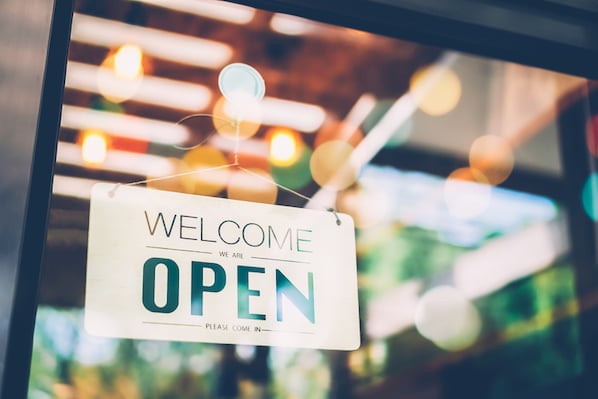While Google rankings remain foundational for local search, local search is no longer confined to the search engine results pages (SERPs) anymore.
Searchers are getting answers to queries like “find a plumber near me” through voice search. People are also using tools like ChatGPT or AI mode to search for long, nuanced queries, such as “I’m hosting a party for 100 guests at [a local venue], and I need recommendations for caterers in [area] who can cater for a range of dietary requirements.”
It’s local SEO that’s going to get you to the top of SERPs, in AI search, and it’ll make you the go-to recommendation for voice agents, too.
To help you optimize your business for local SEO across all platforms, I’ve created a comprehensive guide covering local SEO tips and tools.
Table of Contents
Search engines rely on signals such as local content, social profile pages, links, and citations to provide the most relevant local results to the user to gather information for local search.
With local SEO, businesses can use this to position their products and services to local prospects and customers searching for them.
1. Optimize your Google Business Profile (GBP).
Your Google Business Profile is the foundation of local search. It’s a Google tool, and therefore, it carries weight in the search engine’s algorithms. An update to GBP is a direct communication to Google.
If you haven’t already, create an account, set it up, and optimize it.
Here’s how to do that:
Step 1: Make sure you’ve got a Google account.
If you don’t have a Google account, set one up here. Enter your first name and (optionally) surname, then provide your date of birth.
Tread carefully; read on before proceeding. You’ll be encouraged to create a Gmail email address that will be associated with your Google account.
Alternatively, you can use your work email. And I highly recommend that you do.
In my experience, many businesses, especially small ones, set up too many accounts; some things are set up in their personal email, while others are set up in their business email, leading to confusion.
All business-related things are best set up on your business account.
If you want to use your own email, you need to click “Use your existing email.”
It’s actually really easy to miss this, so here’s a screenshot highlighting where it is.
It’s the page after you provide your date of birth:
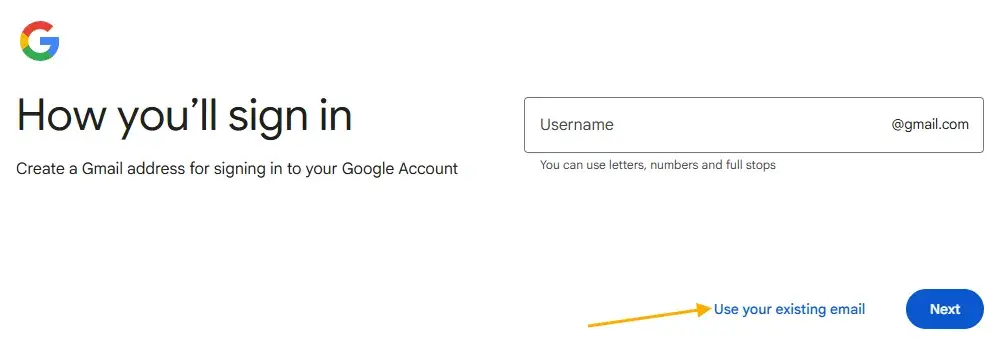
Step 2: Create your GBP page.
Create and verify a Google Business Profile page by following this link.
You’ll go through a series of pages, asking for information like:
- Business name
- Business type
- Website address
- Business category
- Business hours
- Description
- Photos
- Address
Important note: You need to use your actual business address, and Google will verify it. GBP used to send a postcard to the address with a verification code, but more recently, the functionality changed, and you need to send a video of your premises.
Here’s a screenshot showing what Google asks for:
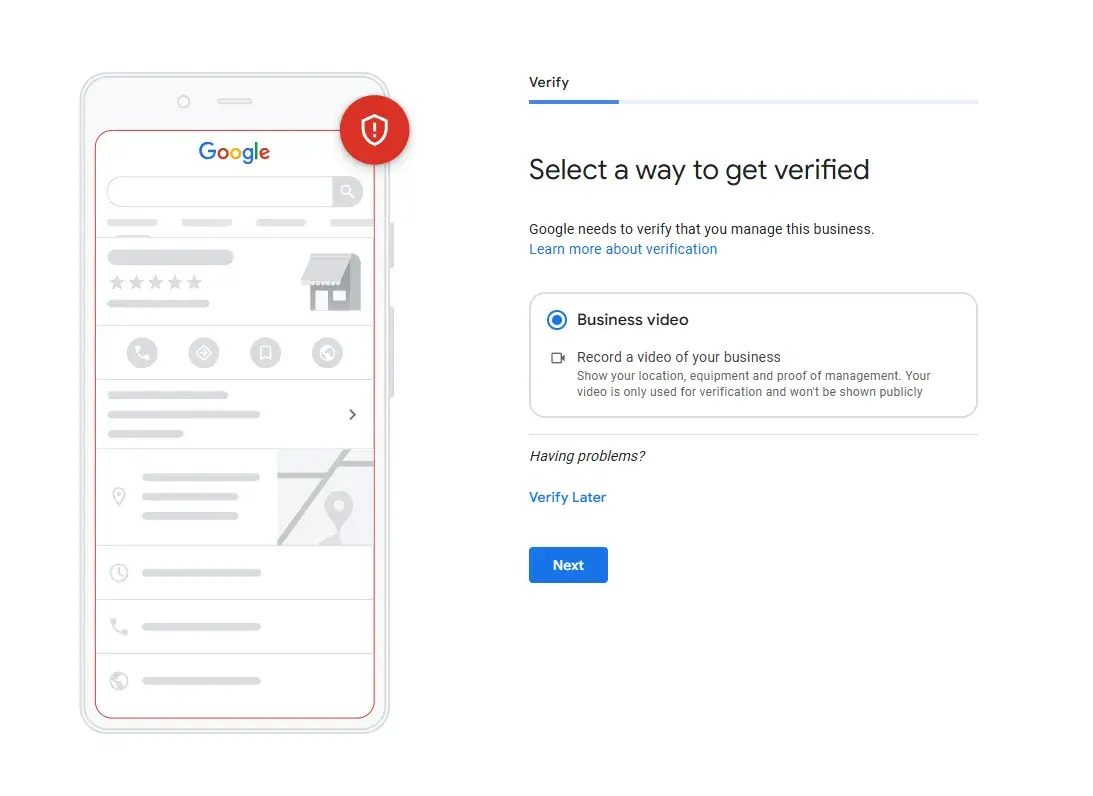
They ask for a video showing your location, equipment, and proof of management.
You can see how GBP holds weight with the algorithm; Google won’t let anyone create a profile without it.
Once you’re set up, when you visit Google, logged into the associated Google account, you’ll have a view that looks like this:

Step 3: Complete the optimization.
The goal with GBP is to optimize it completely. And do it in an SEO friendly way.
There are so many opportunities for optimization, including:
- A keyword-optimized description, including your most important keywords.
- Add videos and images, and optimize the file names before you upload them.
- Contact details, make sure they are correct.
- Business opening hours. Remember to update them during holidays.
- Reviews. Ask clients or customers to leave reviews.
- Reply to reviews authentically. Where natural, you can drop in keywords or locations. For example, “We appreciate your feedback on [product/service] in [city, state]. We value your input and look forward to working with you again. Thank you from the [full company name] team.”
- Start using Google posts to add updates. You don’t have to do this regularly, like you would on socials, but consider updating them every so often.
Don’t just do this for the SEO. By having reviews and keeping your contact information and operating hours up to date, you’re improving the experience for potential customers to find you.
If this didn’t persuade you to complete your profile, these stats from Google might: “Customers are 70% more likely to visit and 50% more likely to consider purchasing from businesses with a complete Business Profile.”
2. Create Google Business Profiles for every location.
If your business operates from more than one physical address, each branch should have its own verified Google Business Profile (GBP). Google treats every location as a distinct entity in search and maps, and without separate profiles, only your main branch is likely to appear in local results.
Here’s what a search for the restaurant chain Chipotle looks like:
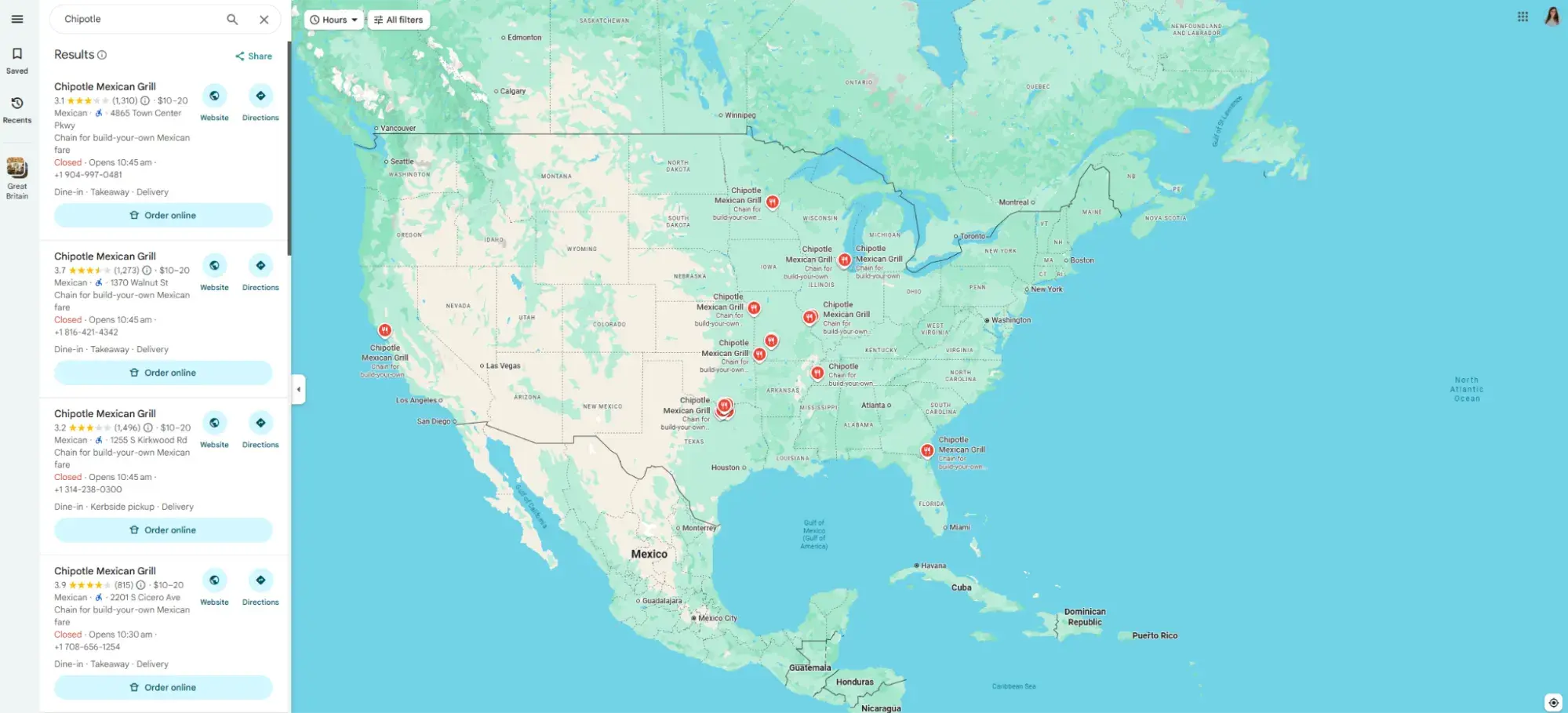
There are many locations, each with its own set of details, including opening hours, location-specific reviews, address, and phone number.
Each website link points to a location page (more on this later).
Here’s what Chipotle Kansas City looks like:
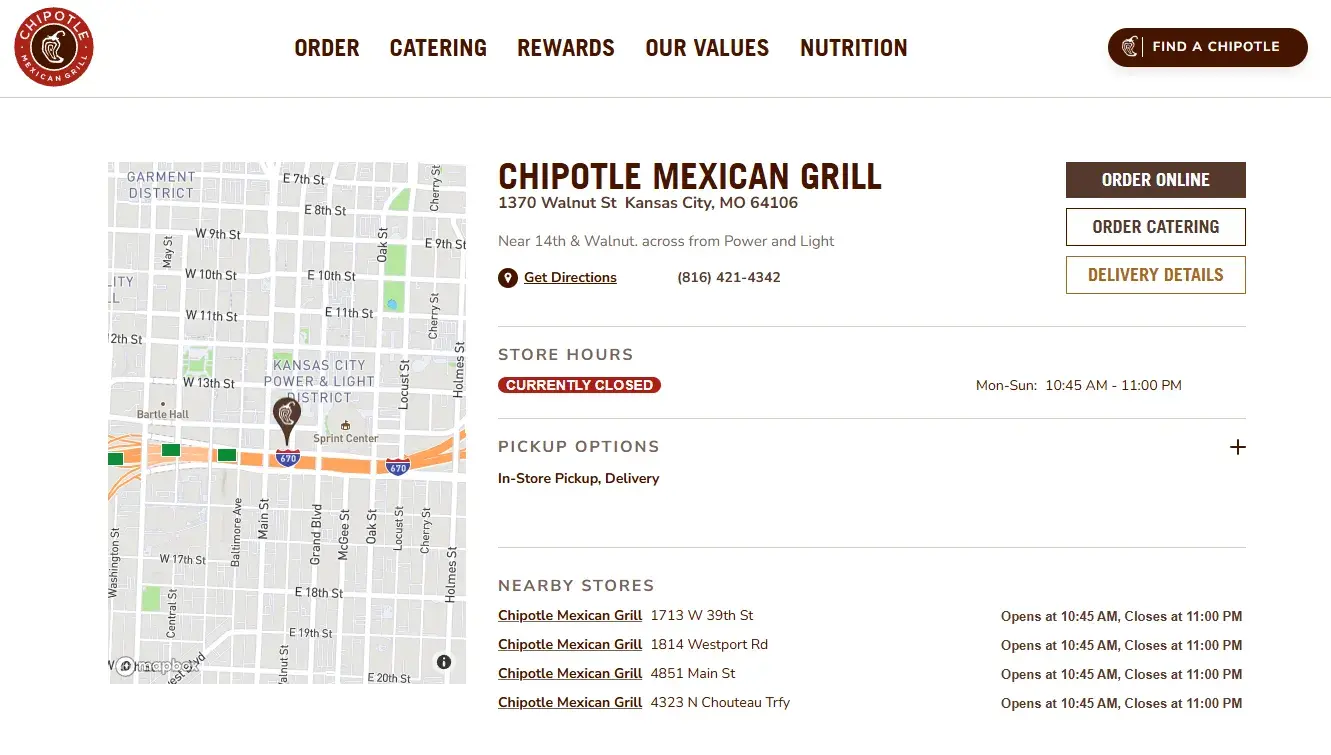
Pro tip: Managing multiple locations can be overwhelming and time-consuming when done manually. You can bulk upload details to GBP using a spreadsheet. Read this Google document on how to do it, including all the relevant fields.
3. Ensure your name, address, and phone number are consistent online.
You already know that providing the correct details is important, but these details might be more important for your SEO than you realize.
These details are known as NAP.
What does NAP mean in local SEO?
The acronym NAP stands for the name, address, and phone number (including the area code) of a business.
Include your NAP within your Google Business Profile. You should have it clearly and accessibly displayed in crawlable HTML text on your site, allowing Google to display it more effectively in location-based search results.
In other words: Avoid the common mistake of only including the NAP within an image. Search engines can’t crawl images like HTML text.
The most common location for the NAP is in the footer or header of the site. Additionally, you should include your NAP on a “Contact Us” page as well.
Inconsistent or incomplete NAP data sends mixed signals, which can erode trust in both Google’s algorithms and potential customers.
It’s more important than you might think, and here’s why:
- Voice search relies on it. When someone says, “Call the nearest [service]” or “Find a [business] near me,” assistants like Siri, Alexa, and Google Assistant retrieve phone numbers and addresses directly from Google Business Profile and other structured data sources. If your NAP isn’t correct, that customer call or visit goes to your competitor.
- AI search depends on clean data. Generative AI and Google’s AI Overviews use verified business data to populate answers. If your NAP is scattered, missing, or outdated, your business may be excluded from those summaries entirely.
- Trust signals for customers. In BrightLocal’s research, 63% of consumers said incorrect business details would stop them from using a local business. Consistency isn’t just about SEO — it’s about credibility.
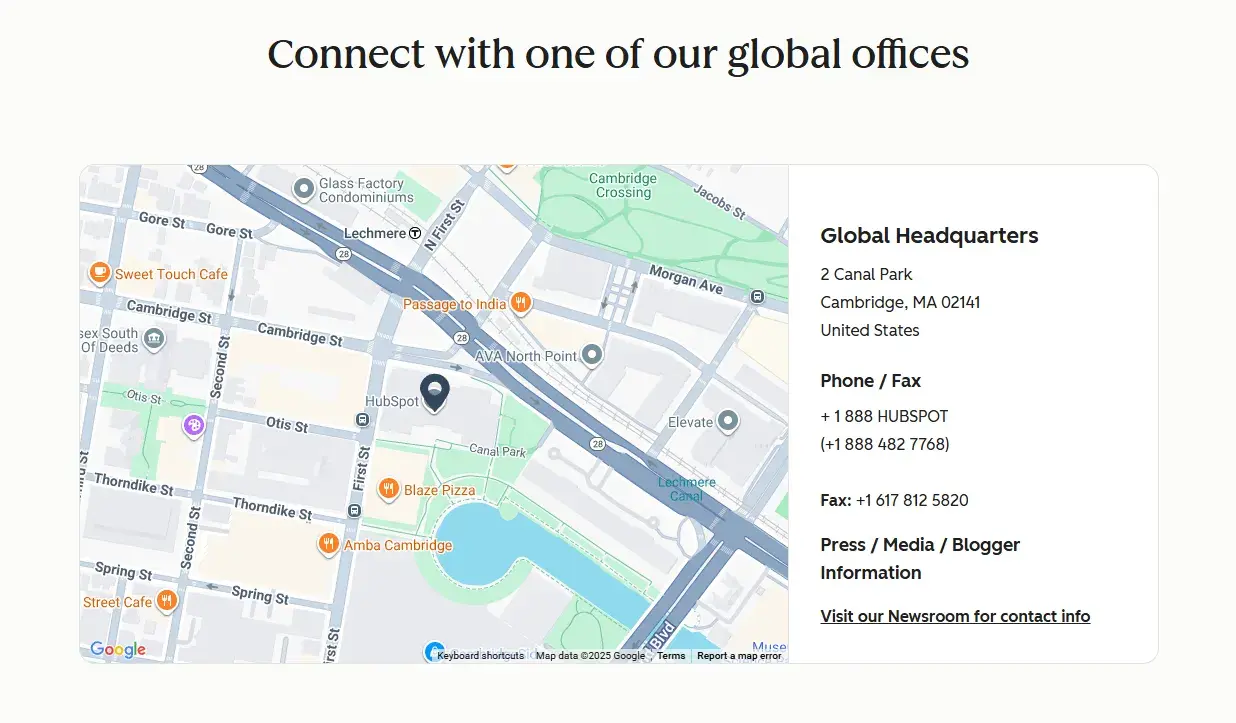
Pro tip: When you add your NAP to your website, include definitional language. In the HubSpot screenshot above, the data is clear. The address is labeled “Global Headquarters,” and the phone number and fax are labeled accordingly. This makes it easy for AI tools and voice tools to parse and cite the information.
4. Optimize online directories and citations.
Your NAP details don’t just appear on your website or Google Business Profile. They’re also available on social media platforms, online directories, mapping services, and review platforms.
To strengthen local SEO, make sure your business is listed everywhere possible and that the information is consistent across all platforms.
Even small discrepancies can weaken trust signals.
For example, using “Road” in one line of your address and “Rd.” in another is inconsistent. Using “[Business Name]” and “[Business Name Limited] is inconsistent.
And these inconsistencies won’t help you, especially if they happen on more important elements.
Sources like Google or ChatGPT aggregate the content you publish about your business and give the information to searchers through search engine features.
The knowledge panel, for example, takes information from across the web and creates a panel, available on Google search, about your business.
Here’s what HubSpot looks like:

Note the address label. It’s “Headquarters,” which is exactly what HubSpot has on its website.
You can build consistency by creating profiles and adding your business to relevant directories.
For U.S. companies, these four map data aggregators provide many map data for Apple, Yelp, Bing, Google, TripAdvisor, and more:
Consistency is key: Verify that your citations are consistent and complete across these four data aggregators.
If Google can’t determine which information about your business is correct, it may not show your business at all in search results.
Pro tip: Remove any duplicate listings you find in online directories. And while you’re at it, get a Chamber of Commerce membership in your community to gain an external inbound link specific to your area.
5. Add structured data and schema markup.
This is a fairly advanced tip, so you may want to revisit it later, but I’m sharing it here because it ties in nicely with the importance of using definitional language and labeling data on your website.
Structured data and schema are pieces of code that exist on your website. As the name suggests, this code helps structure information on a website. So, if you have a telephone number on your website, you can clearly define it as such.
It is visible to Google, but not visible to website visitors (unless they want to inspect the code).
Search engines use structured data and schema to understand your business details and display them in results.
By adding schema markup, you’re giving Google and other search engines a reliable way to read details about your business. This might include information about NAP, services, reviews, and operating hours.
Include things such as:
This code can increase your chances of appearing in rich results, map packs, and AI-generated summaries — all of which drive more clicks and calls.
You will likely need some developer support to implement the schema and structured data in full. It’s a broad subject, so you may need additional resources to understand and implement it fully.
Read:
- How to Use Schema Markup to Improve Your Website’s Structure. This HubSpot article includes examples of how schema has benefited websites with rich results in the SERPs.
- How Local Business Schema Can Boost Your Company’s Visibility Online. This HubSpot article includes a guide to adding local business schema, and you’ll definitely want to follow that.
- Local schema documentation from Google explains local schema in full and provides examples of code you can copy and paste, and edit. The same documentation exists for Organization, Review, and FAQ schema.
6. Optimize URL, title tags, alt text, headers, meta description, and content.
Use location-based keywords across your content, and especially in key SEO levers such as:
- URLs
- Title tags
- Headers
- Alt text
You can also sprinkle locations in your content and meta description.
Just keep it natural.
Often, people will search for services or products, then “near me.” For example, “restaurants near me,” and if you’re using keyword research tools, you might find “near me” keywords. You don’t optimize for this keyword.
Optimize for the location, like “Italian Restaurant, New York,” and expect Google to apply the “near me” search when someone looks for it.
When creating pages that are optimized for local search, consider:
- URLs. Keep them short, descriptive, and include the service + location where relevant (e.g., /restaurant-new-york/).
- Title tags & meta descriptions. Incorporate both your service and local modifiers (“Emergency Plumber in New York | [Business Name]”).
- Headers (H1–H3). Use headers to reinforce topical relevance and location, breaking content into scannable sections (e.g., “Why Our London Plumbers Are Available 24/7”).
- Alt text. Alt text must be descriptive and written with screen readers in mind, but it also presents an opportunity to incorporate local SEO. For example, instead of “coffee shop,” you can write, “[coffee shop name’s] storefront at [address]; viewed from across the street.” This improves accessibility and supports local SEO.
- Content. Write for people, not just algorithms. Include locally relevant details, such as neighborhoods, landmarks, case studies, or customer testimonials that link to the location. These “local signals” show Google you’re tied to a specific geography.
7. Add location pages to your website.
If you have more than one brick-and-mortar location, create location pages, like Chipotle does:

Location pages offer visitors detailed information about a specific location.
Chipotle includes:
- Name
- Address
- Phone number
- Directions
- Details about how to order
- Store hours
- Pick up options
- Nearby restaurants
You might also include:
- Unique store descriptions.
- Parking/transit information.
- Promotions.
- Testimonials from happy customers.
Pro tip: When adding a map, don’t just place an image; embed Google Maps. It helps connect all your digital entities. Here’s how you add a Google Map to your website on your respective location page(s).
8. Create local content.
Ideally, location pages would have some unique content, and I don’t just mean telephone numbers and addresses.
Why?
Duplicated content across multiple location pages can dilute your SEO efforts and even prevent those pages from ranking.
Unique content might look like:
- Details on a location page, such as the neighborhood, nearby landmarks, parking or transit options, and community involvement, show search engines that you’re tied to that area and not just manipulating local search algorithms.
- Blogs and resources that are specific to the area. If the area affects your business, you can write blog posts about it. For example, someone selling security cameras might write about crime rates in the region and the impact security measures have. Alternatively, you could write blogs about your community involvement, such as supporting a local charity event.
- Local case studies and reviews. People want to see that you’re a genuine business operating in that area. Include testimonials from local customers or case studies of work completed within that area.
Pro tip: Think of your location pages as a hub for each branch and for readers on the page. The more authentic and locally relevant they are, the more likely Google is to surface them in local search results. And the more confidence customers will have in choosing you.
These location-specific content ideas don’t need to exist on your location page. You can create new pages for them, then link from your location page.
9. Improve your internal linking structure.
Internal linking is the practice of connecting one page on your website to another with hyperlinks. Unlike external links (from other websites), internal links live entirely within your own domain.
For example, if you have a local page and you link to a blog on your page about your work with a local charity, then that link is an internal link.
Internal links can significantly boost SEO rankings.
Why does internal linking matter? It does the following:
- Helps pages rank for specific keywords. When you link, the text you link with (called anchor text) should include the keyword you want a page to rank for. Above, I’ve linked to a supporting blog with the anchor text “internal linking,” because this is the page optimized for that keyword. If someone searches for that keyword, I want to encourage Google to display the linked-to page.
- Authority flow. Internal links pass on “link equity” or authority, distributing ranking power from high-authority pages (like your homepage or popular blogs) to other key pages.
- User experience. Visitors can easily find related content. If someone is ordering a service in Kansas City, they might be interested in reading case studies about work completed in that area.
- Helps site structure. A logical internal linking system makes it easier for Google to crawl your site and understand which pages are most important.
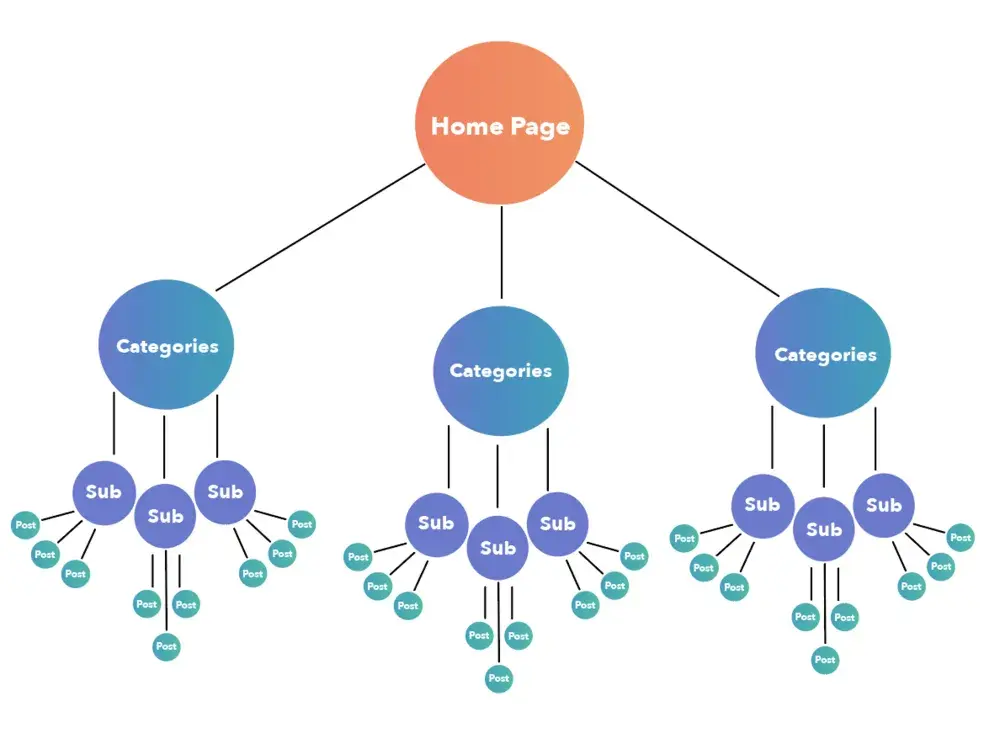
If you want to improve your internal linking structure but aren’t sure where to start, check out Kissmetrics’ The Seven Commandments of Internal Linking for Top-Notch SEO.
10. Get backlinks from local, relevant, and authoritative sources.
Backlinks (also known as inbound links) are crucial for SEO. If you’re serious about local search, you can use backlinking to bolster your local SEO efforts.
Think of inbound links like a vote. If someone links to your website, then they’re happy to affiliate their site with yours. It acts a bit like a word-of-mouth recommendation. It signals to Google that you’re a legitimate company.
Here are a few ways to get local inbound links:
- Guest blog posting is a great tactic overall. If you guest post on other local or related businesses, they will link to you.
- Ask clients or customers to write about their experiences working with you in the local area, and have them link to your website. This is more easily done in B2B spaces.
- Get local press & media mentions by sharing newsworthy updates (expansions, events, sponsorships) with local journalists and publications.
- Join the local commerce and get active in the local networking community.
- Offer sponsorships & community involvement by sponsoring a charity event, youth sports team, or community initiative. These often come with a backlink on event or organization websites. Plus, it’s often newsworthy.
- Offer a small scholarship or grant tied to your industry. Local universities and schools often link back to participating businesses.
- List your business in local directories if they’re available.
11. Get reviews.
I’ve touched on reviews throughout this article, but I wanted to pull it out as a separate point, because I think it’s really important.
Customer reviews are a strong signal in local SEO, and they’re a strong signal for prospects, too!
More importantly, reviews drive revenue. According to Reutatinox, “Every additional one-star Yelp rating causes an increase in the business’s revenue as high as 9%.”
Google Business Profile may factor in reviews when determining which businesses to display in the local pack. After all, Google always wants to provide the best listings and content to its users, and good reviews suggest that you are a suitable recommendation.
Best practices for reviews:
- Consistently ask for reviews, not just in one-off campaigns.
- Respond to every review, good or bad — it shows customers (and Google) you’re active and engaged.
- Don’t script reviews, but do encourage customers to be specific (mention the service, location, or staff member they dealt with).
Pro tip: When I ask for Google Business Reviews, I visit my own Google Business Profile and click “Write a Review.” A pop-up box will appear. Copy the URL and share it with prospective reviewers, asking them to leave a review. It makes it so easy for them and increases the chances of them writing the review.

12. Optimize for voice search and AI search.
Voice search and AI search are changing how people discover businesses.
When we type, we think in keywords: “dentist Boston” or “best Thai food near me.” But when we speak, we use natural, conversational language: “Where’s the nearest dentist that’s open late tonight?”
This difference matters because voice assistants and AI-driven results (such as Google’s AI Overviews) rely heavily on structured, verified data and conversational context.
Why this matters for local SEO:
- Google Business Profile is the source of truth. Voice commands like “Call [business name]” or “Find [service] near me” pull directly from your GBP data. If your NAP details or hours are wrong, voice search will misdirect customers — or skip you entirely.
- Conversational queries dominate. Optimizing only for clipped, keyword-heavy terms is no longer enough. AI and voice systems look for content that mirrors how people speak: “Who offers same-day boiler repairs in London?” or “What’s the best coffee shop near Victoria Station?”
- Voice searches are overwhelmingly local. Near me queries have surged in recent years — and AI voice assistants prioritize businesses with consistent data across directories, schema markup, and GBP.
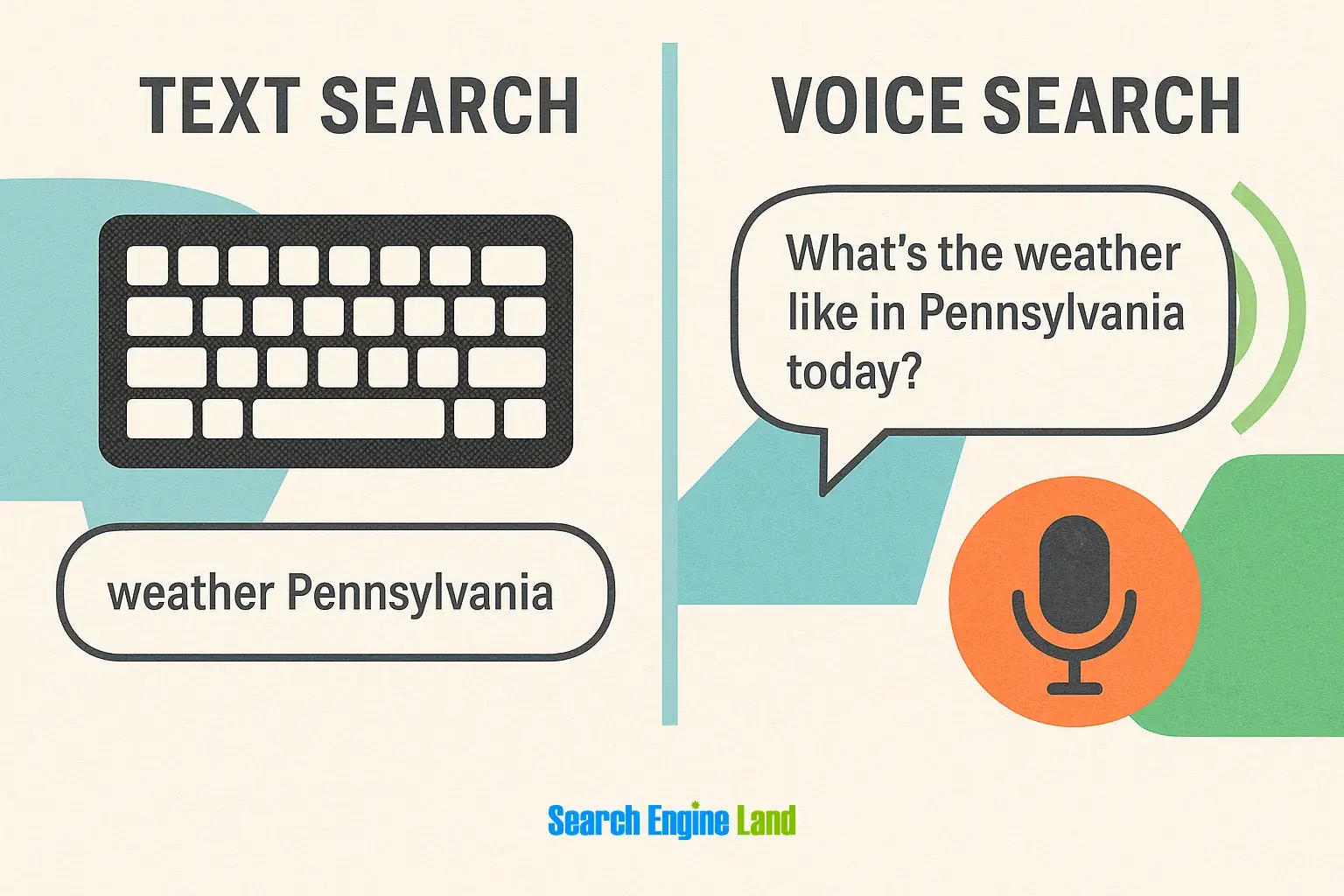
How to optimize:
- Add FAQ content in a conversational style, using prompts like Who… Where… What’s the best…
- Use schema markup (LocalBusiness, FAQ, Review) so AI and voice assistants can easily parse your information.
- Ensure your NAP data is consistent everywhere — mismatches weaken trust and reduce your chances of being listed.
- Write in a definitional style when answering common queries. For example: “Where to find us: [address]. We’re located just opposite [landmark].” (Go back to the HubSpot example, where they labeled their address with “Headquarters.”
13. Ensure your website is mobile-friendly.
Local and mobile search go hand in hand because people are often on the go when looking for a local recommendation.
We’ve all been in the middle of a city and pulled out our mobile phone to find our favorite restaurant or coffee chain, haven’t we?
Your GBP is enough, in many cases, because common ways people will use your site in a mobile environment are to:
- Look up reviews.
- Find directions to your location.
- Search for contact information.
GBP handles all of this for you, and with just a click, people can access Google Maps directions to your store.
However, there will always be a few who want to click through to the site. And those who do need to find themselves on an optimized, fast, and mobile-friendly website. Otherwise, you might lose them!
14. Perform regular local SEO audits.
Once you have the fundamentals down, it may be tempting to put your foot on the brake. However, SEO is an ongoing and intuitive process. Instead of stopping there or simply making changes and seeing what sticks, it helps to conduct a comprehensive audit to assess your website’s current state and identify areas for improvement to achieve your goals.
A local SEO audit may include the following:
- Google Business Profile Audit - How does your GBP appear in the SERPs? Is the information accurate?
- Google Search Console Audit - Is your site crawlable? Does it have any errors that would hinder indexing?
- On-Page SEO Audit - Does your site accommodate all the on-page SEO elements that help ranking?
- Citation Audit - Are all of your citations correct in the top business directories?
- Competitor Analysis - How does your site match up with your competition’s? Are there any gaps that you need to close? How do you match up in terms of inbound links, content, design, and positioning?
- Website Audit - How well is your website performing?
Local SEO Tools
Now that we’ve covered how to optimize your business for local SEO, let’s explore some practical tools you can leverage to improve your ranking in the areas where it matters most.
1. HubSpot’s AEO Grader
Pricing: Free

HubSpot’s AEO Grader assesses your brand’s visibility across AI-powered search and how your brand is represented in generative AI results.
While it’s not strictly a local SEO tool, it will show you how people are talking about your business and what content AI is finding. This overlaps significantly with what people are saying about your company and in reviews, which are all listed on your GBP.
According to Reutatinox, “Reputation management has become a daily necessity rather than a periodic concern.” An astounding 97% of consumers conduct online searches for local businesses, and 12% do so daily. Your business needs to manage its online reputation to increase its chances of visibility.
What I like about HubSpot’s AEO grader: It’s free and extremely valuable. You can get a picture of what everyone is saying about your brand (or your competitors) in one place, and in minutes.
2. Semrush Local With GBP AI Agent
Pricing: $99 per month/domain
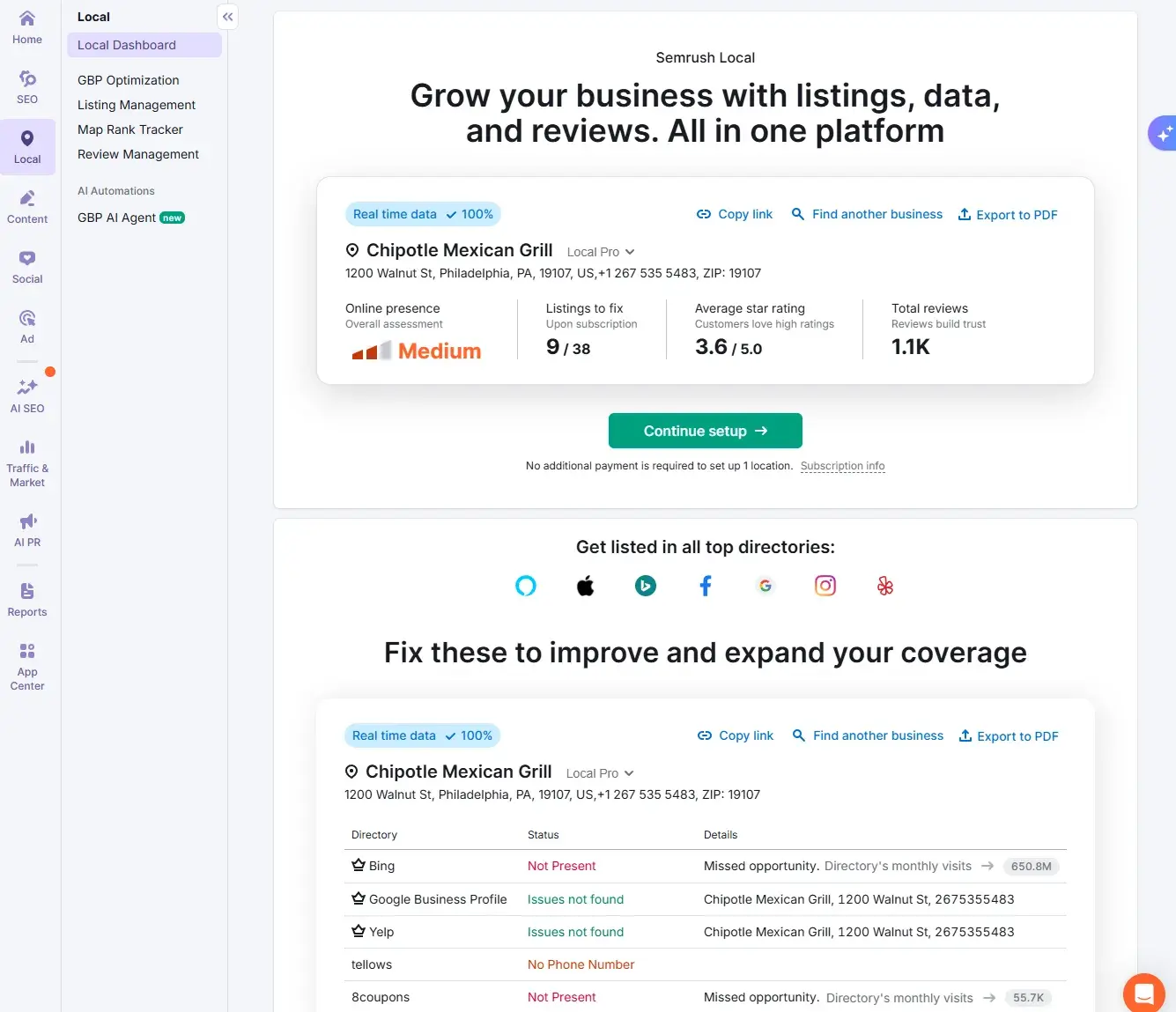
Semrush’s Local SEO dashboard analyzes your local SEO presence. It scores how you’re performing, and it shows you where there are NAP discrepancies so you can solve them.
The GBP AI Agent takes the GBP admin out of your hands.
It can:
- Generate and schedule posts.
- Respond to reviews using AI-assisted replies.
- Monitor and suggest edits to your profile.
- Maintain consistency across multiple locations.
The goal is to keep your GBP active and accurate without constant manual effort, so your business remains visible and authoritative in both traditional local search and AI/assistant-driven queries.
What I like about Semrush: It is a powerful tool that does a lot more than just Local SEO. Semrush is the best auditing and analysis tool with the best user experience (UX). Every SEO needs a tool like it. I’ve had the Guru package for years, but if you just want to focus on the Local SEO aspect, you can.
3. Buzzstream With AI-Powered Media Lists (ListIQ)
Pricing: Starter Plan, $24/month; Growth Plan, $124/month; Professional Plan, $299/month; Custom Plan, $999/month.
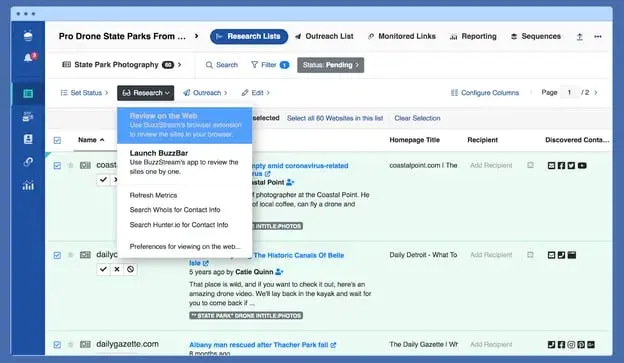
BuzzStream facilitates earning local backlinks, which helps you identify and build relationships with local influencers by researching influencers, tracking conversations, and providing reporting insights into your outreach campaigns, team performance, and link placements.
BuzzStream’s AI capabilities are centered around ListIQ. It uses an AI research model to build highly targeted media and outreach lists ready for you to target.
What I like about Buzzstream: The ListIQ AI functionality is fast and efficient. The AI extracts accurate details from Google News searches, including journalist information, making it easy to pitch to the right journalists.
4. Whitespark
Pricing: Get started with as little as $1 per location, and customize your solution with the features you need.

Whitespark has a range of features for local SEO. One is its Local Platform, which tracks changes made to your Google Business Profile, whether by users or Google itself.
When a change is made, you’ll be alerted to it so you stay in control without having to check everything manually.
The local citation finder is also a popular choice for those who want to work on their NAP consistency. A local citation is any online mention of a local business’s name, address, and phone number.
Citations matter because they help surface local businesses in online search, and when local businesses actively manage their sources to ensure data accuracy, it promotes trust in these online listings.
Whitespark knows this realm well — really well. Whitespark offers local listing management, recommends where to list your business, examines your competition, and robustly builds and monitors your citation growth for better local search rankings.
What I like about Whitespark: Changing GBP data can have a significant impact on businesses, yet it is often impossible to manage at scale, and it can take months to spot a change. Whitespark takes the workload out of managing your business’s data by alerting you to changes. And you can make the change by accepting or rejecting it in their dashboard.
5. Screaming Frog
Pricing: Free Basic Version; Paid Version, $279/year.
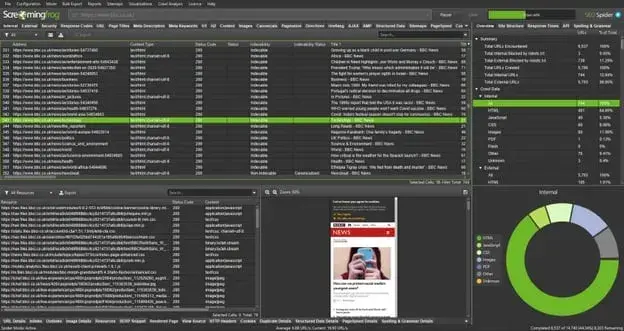
This desktop program crawls websites’ links, images, CSS, scripts, and apps from an SEO perspective. Curious if you have any 404s? Or wondering about missing meta descriptions or H1s? Screaming Frog offers free and unlimited URL analysis for up to 500 URLs, with additional features available in its paid version.
What I like about Screaming Frog: I’ve used Screaming Frog for years, and it is a fully comprehensive tool. You can set up automated crawls that run in the background, or run the software when looking for specific issues, such as page speed on all your location pages.
6. Moz Local
Pricing: Lite Plan, $16/month; Preferred Plan, $24/month; Elite Plan, $33/month.

Less expensive than most of its counterparts, Moz Local will ensure your business listing has been verified on Google and Facebook and distribute your listing across the search ecosystem.
Additionally, Moz Local will collaborate with data aggregators to help push listings, ensuring your business gains visibility.
What I like about Moz Local: It’s user-friendly and integrated into the broader Moz ecosystem, so if you’re already using Moz tools, Local feels like a natural extension.
7. BrightLocal
Pricing: Single Business Plan, $29/month; Multi Business Plan, $49/month; SEO Pro Plan, $79/month.

BrightLocal is a comprehensive SEO tool suite built explicitly for local business marketing needs.
The tool can help you generate and monitor reviews on local sites, understand your local search performance, and analyze nearby competitors.
BrightLocal also offers client access and white-labeled reporting — making it a solid fit for agencies and brands alike.
What I like about BrightLocal: Rather than juggling separate tools for rankings, reviews, and citations, BrightLocal gives you a unified view so you can see weak spots immediately.
Improve your business visibility with local SEO.
Local SEO is an integral part of any SEO strategy for local businesses. It will help your audience find you when they search online if you have a storefront or service area.
I’ve spent over a decade working in SEO, and local remains one of the most impactful and measurable areas to invest in.
Why?
Because it is so targeted. Why target a keyword like “SEO Services” when you can get targeted and capture an audience who specifically want a local provider that they can meet face-to-face?
If you take one thing from this guide, let it be this: Local SEO isn’t just about ranking in Google — it’s about showing up wherever your customers are searching, whether that’s in maps, voice assistants, or AI-powered answers. Where my clients have had excellent SEO rankings in Google, they’ve also shown up in ChatGPT.
Start with the fundamentals, layer on advanced tactics like schema and voice optimization, and keep your data accurate and active. Do that, and you’ll not only improve your rankings — you’ll win the trust of the people right in your community.
Editor's note: This post was originally published in April 2018 and has been updated for comprehensiveness.
Local SEO


.png)


![Local SEO Audit: Everything You Need to Know [+ How to Perform One]](https://53.fs1.hubspotusercontent-na1.net/hubfs/53/Local%20SEo%20Audit%20Final.jpg)

![What Are Local Citations [+ 4 Steps to Build Them for Your Business]](https://53.fs1.hubspotusercontent-na1.net/hubfs/53/GettyImages-1331173398%20(1)%20(1).jpg)



